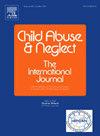COVID-19期间的儿童创伤和孕产妇围产期抑郁:应激致敏假说
IF 3.4
2区 心理学
Q1 FAMILY STUDIES
引用次数: 0
摘要
背景围产期抑郁症状(PDS)是影响孕妇孕期和产后健康以及婴儿发育的危险因素。COVID研究表明,在这段压力加剧的时期,PDS明显增加,但也强调,并非所有女性都有患围产期抑郁症的风险。这就需要确定可能导致某些个体对COVID-19大流行等人口压力源敏感的因素。目的基于应激致敏模型,评估新冠肺炎大流行期间4个时间点(2个产前和2个产后)孕妇儿童创伤(CT)与抑郁症状的关系。方法加拿大母亲(N = 117,年龄29.77岁,SD = 3.18,初产妇占63.2%,白种人占98.3%,有CT史的占23.1%)在妊娠首、中期(T1)和晚期(T2)以及产后2个月(T3)和6个月(T4)完成了CT (CTQ)和抑郁症状(EPDS)的自我报告测量。使用MPlus进行结构方程建模(SEM)分析。结果在COVID-19大流行期间,母亲CT严重程度与产前和产后抑郁症状直接相关。CT也通过产前抑郁症状与产后抑郁症状间接相关。结论sct与产后抑郁症状具有持久的相关性,部分原因在于其在首次COVID-19爆发期间的产前抑郁中所起的作用。将讨论结果对围产期护理的影响。本文章由计算机程序翻译,如有差异,请以英文原文为准。
Childhood trauma and maternal perinatal depression during COVID-19: A stress sensitization hypothesis
Background
Perinatal depressive symptoms (PDS) are a risk factor for maternal well-being during and following pregnancy as well as for infant development. COVID studies documented a definite increase in PDS during this period of heightened stress, but also highlighted that all women were not equally at risk of perinatal depression. This calls for the identification of factors that could contribute to sensitizing certain individuals to populational stressors such as the COVID-19 pandemic.
Objective
Based on the stress sensitization model, this study aimed to evaluate the associations between childhood trauma (CT) and depressive symptoms in pregnant women during the COVID-19 pandemic at four timepoints (two prenatal and two postnatal).
Methods
A sample of Canadian mothers (N = 117, Mage = 29.77 years, SD = 3.18, 63.2 % primiparous, 98.3 % White, 23.1 % with history of CT) completed self-reported measures of CT (CTQ) and depressive symptoms (EPDS) during the first or second (T1) and the third trimester of pregnancy (T2), as well as at 2 months (T3) and 6 months (T4) postpartum. Structural equation modeling (SEM) analyses were performed using MPlus.
Results
Maternal severity of CT was directly associated with pre- and postnatal depressive symptoms during the COVID-19 pandemic. CT was also indirectly associated with postnatal depressive symptoms via prenatal depressive symptoms.
Conclusions
CT had an enduring association with postnatal depressive symptomatology in part due to its role in prenatal depression during the first COVID-19 outbreak. The implications of the results for perinatal care will be discussed.
求助全文
通过发布文献求助,成功后即可免费获取论文全文。
去求助
来源期刊

Child Abuse & Neglect
Multiple-
CiteScore
7.40
自引率
10.40%
发文量
397
期刊介绍:
Official Publication of the International Society for Prevention of Child Abuse and Neglect. Child Abuse & Neglect The International Journal, provides an international, multidisciplinary forum on all aspects of child abuse and neglect, with special emphasis on prevention and treatment; the scope extends further to all those aspects of life which either favor or hinder child development. While contributions will primarily be from the fields of psychology, psychiatry, social work, medicine, nursing, law enforcement, legislature, education, and anthropology, the Journal encourages the concerned lay individual and child-oriented advocate organizations to contribute.
 求助内容:
求助内容: 应助结果提醒方式:
应助结果提醒方式:


